Strap 47k across the RCA input to provide DC path.
(rtfm!)
Indeed. Should have read the FM. My only defence is that that part was not in the first
revision of the data sheet
Indeed. Should have read the FM. My only defence is that that part was not in the first
revision of the data sheet
We like to learn from other people's mistakes.
Hi Guys
I dodn't often post here but though you guys may be interested in a listening session I had with the Ncores.
An acquaintance out here in Aus where I am lent me some Ncores and a few hours ago popped them in my system with a NAD M51 as source and ML3 Reference as speakers. Here are some of my initial impressions.
Well how do they sound - clear, clean, pure and neutral - very neutral. *With the NAD 51 as source I heard the exact same setup with Mac 501's yesterday and know the sound of my NAKSA 100 very well. *First how do they compare to the Mac's - very well thank you very much. *Bass grip not quite as good - still pretty good mind you - but those Mac's have simply amazing bass grip. *They have a slightly harder sound with maybe a trace of glare - maybe - than the Mac's but the Mac's to me have a slighly tubey midrange and a slight veil - this doesn't have the veil - but have a slight hardness and etched character the Mac's lack and the midrange isn't quite as enjoyable. *The Mac's are better to listen to for long periods IMHO. *The Trafomatic totally clobers it for midrange divineness - but then again no amp I have heard touches it in that department - although the Arions come close. *It's not like the NAKSA which Hugh has voiced to sound really good for long periods - but is not the last word in neutrality - and is more the type of amp you go - ahh - that's nice when you hear it - this amp isn't. *Its more the type of amp you go - hmmm - exactly what character does it have and you have to listen to it for a while to lock onto it and notice a few things like the slight hardness etc. *How does it compare to the Arions? *I will see if I can do a direct comparison at some future date but most certainly a comparison with my aquantances that have heard the Arion's is on the cards. *My view is the Arions simply sound real - this amp sounds slighly hard, etched and contrived in comparison. *How does it compare to the NAD C4390DD - the NAD has greater slam but sort of sounds a bit thicker for want of a better word. *But overall fed with the NAD M51 I would say they are about equal - just slightly different.
I hope to, when I have someone to give me a hand, be able to rig it up through my QOL Completion stage so we can check it out against my Bybeed up PDX. *I will be taking it over to an acquaintance here in Aus, Rob's place, tomorrow for comparison against his Spectron on his Ambiance Ribbons.
I will also give it a go with my Playback Designs a bit later - it is extremely good with DSD having a very realistic natural sound.
Overall this is a very very good amp - up there with some of the better amps I have heard. *If you prefer a highly neutral and accurate sound and are not worried it may not be relaxing to listen to for long periods then it could be just your ticket.
Thanks
Bill
I dodn't often post here but though you guys may be interested in a listening session I had with the Ncores.
An acquaintance out here in Aus where I am lent me some Ncores and a few hours ago popped them in my system with a NAD M51 as source and ML3 Reference as speakers. Here are some of my initial impressions.
Well how do they sound - clear, clean, pure and neutral - very neutral. *With the NAD 51 as source I heard the exact same setup with Mac 501's yesterday and know the sound of my NAKSA 100 very well. *First how do they compare to the Mac's - very well thank you very much. *Bass grip not quite as good - still pretty good mind you - but those Mac's have simply amazing bass grip. *They have a slightly harder sound with maybe a trace of glare - maybe - than the Mac's but the Mac's to me have a slighly tubey midrange and a slight veil - this doesn't have the veil - but have a slight hardness and etched character the Mac's lack and the midrange isn't quite as enjoyable. *The Mac's are better to listen to for long periods IMHO. *The Trafomatic totally clobers it for midrange divineness - but then again no amp I have heard touches it in that department - although the Arions come close. *It's not like the NAKSA which Hugh has voiced to sound really good for long periods - but is not the last word in neutrality - and is more the type of amp you go - ahh - that's nice when you hear it - this amp isn't. *Its more the type of amp you go - hmmm - exactly what character does it have and you have to listen to it for a while to lock onto it and notice a few things like the slight hardness etc. *How does it compare to the Arions? *I will see if I can do a direct comparison at some future date but most certainly a comparison with my aquantances that have heard the Arion's is on the cards. *My view is the Arions simply sound real - this amp sounds slighly hard, etched and contrived in comparison. *How does it compare to the NAD C4390DD - the NAD has greater slam but sort of sounds a bit thicker for want of a better word. *But overall fed with the NAD M51 I would say they are about equal - just slightly different.
I hope to, when I have someone to give me a hand, be able to rig it up through my QOL Completion stage so we can check it out against my Bybeed up PDX. *I will be taking it over to an acquaintance here in Aus, Rob's place, tomorrow for comparison against his Spectron on his Ambiance Ribbons.
I will also give it a go with my Playback Designs a bit later - it is extremely good with DSD having a very realistic natural sound.
Overall this is a very very good amp - up there with some of the better amps I have heard. *If you prefer a highly neutral and accurate sound and are not worried it may not be relaxing to listen to for long periods then it could be just your ticket.
Thanks
Bill
We like to learn from other people's mistakes.
In that case I am sure I can provide a lot opportunity to learn...
Thx Bill for the feedback.
Some background on why the NC400 sounds the way it does: it is always a dilemma whether an amp should be tuned for things like subjective bass control, sweet mids or not. One of the tricks a Mac does by design is to have a highish output impedance (because of the autoformer) which makes for a more liquid mid-range sound and then to add a subjective sense of bass control by allowing a slight THD rise in the top end. When things like those are really tastefully balanced, such an amp can really make life hard on a "straight wire" amp in a shootout. The signal actually comes out sounding nicer and more impressive than what went in. But on the other hand, I think that to make the greatest number of people happy, one can't afford to give an amp a sound of its own because the number of new fans is probably immediately offset by the number of people who don't like that particular tuning.
But it's tough to resist the occasional sonic touch-up. I can emulate the sound of pretty much any amp out there if I wanted. But so far I'm resisting. If ever I give in, it'll be obvious from the measurements and I hope someone calls me out on it...
Anyhow that's why I decided I actually wanted the NC400 to have this unvarnished, dead-pan delivery.
Some background on why the NC400 sounds the way it does: it is always a dilemma whether an amp should be tuned for things like subjective bass control, sweet mids or not. One of the tricks a Mac does by design is to have a highish output impedance (because of the autoformer) which makes for a more liquid mid-range sound and then to add a subjective sense of bass control by allowing a slight THD rise in the top end. When things like those are really tastefully balanced, such an amp can really make life hard on a "straight wire" amp in a shootout. The signal actually comes out sounding nicer and more impressive than what went in. But on the other hand, I think that to make the greatest number of people happy, one can't afford to give an amp a sound of its own because the number of new fans is probably immediately offset by the number of people who don't like that particular tuning.
But it's tough to resist the occasional sonic touch-up. I can emulate the sound of pretty much any amp out there if I wanted. But so far I'm resisting. If ever I give in, it'll be obvious from the measurements and I hope someone calls me out on it...
Anyhow that's why I decided I actually wanted the NC400 to have this unvarnished, dead-pan delivery.
Anyhow that's why I decided I actually wanted the NC400 to have this unvarnished, dead-pan delivery.
I'm very glad that you did...!!
I'm sure some of the tweakers or recording guys would love that. My Metric Halo LIO-8 has what they call "characters" for just this purpose. You want tube sound, select it and it really does sound like tubes. They have many different types too.I can emulate the sound of pretty much any amp out there if I wanted.
I'm happy you did too but as noted above so many people would love that tool probably.Anyhow that's why I decided I actually wanted the NC400 to have this unvarnished, dead-pan delivery.
This is my NCore build so far;
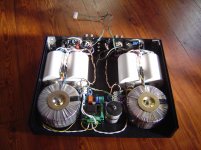
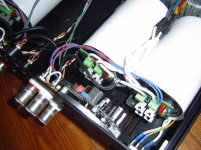
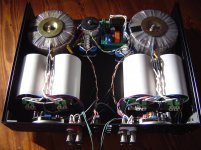
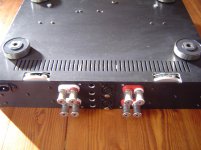
It is temporarily rigged up as a power amplifier but will become an integrated.
The volume section will be a my own design pic controlled 32 step ‘balanced shunt attenuator’ with one relay per level (no combinations) as used in the preamp;
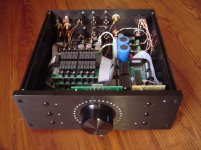
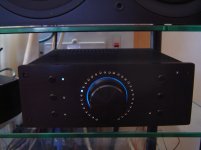
The stand alone preamp has buffer/gain stages based on TO99 op amps with my copy of Walt Jung’s Super Reg. The gain can be set with plug in resistors and is an equivalent design to the buffer front end of UCD, I was using it at 12db gain with four UCD180HG monos (with the on-board buffer stages by-passed) and at 0db gain more recently with the NCore. This buffer stage will not be necessary for the integrated NCore, Bruno has taken care of this.
As for sound quality the UCD180HGs perform exceptionally well bi-amping my KEF 205/2 speakers and were the best sounding amps I had heard in my set up until NCore..




It is temporarily rigged up as a power amplifier but will become an integrated.
The volume section will be a my own design pic controlled 32 step ‘balanced shunt attenuator’ with one relay per level (no combinations) as used in the preamp;


The stand alone preamp has buffer/gain stages based on TO99 op amps with my copy of Walt Jung’s Super Reg. The gain can be set with plug in resistors and is an equivalent design to the buffer front end of UCD, I was using it at 12db gain with four UCD180HG monos (with the on-board buffer stages by-passed) and at 0db gain more recently with the NCore. This buffer stage will not be necessary for the integrated NCore, Bruno has taken care of this.
As for sound quality the UCD180HGs perform exceptionally well bi-amping my KEF 205/2 speakers and were the best sounding amps I had heard in my set up until NCore..
Anyhow that's why I decided I actually wanted the NC400 to have this unvarnished, dead-pan delivery.[/QUOTE]
It's perfect,
can help thinking: you hear the character of whatever equipment you put in front, so stunningly clear, that it's own sonic character is more "invisible" than anything else comes to mind, truly letting even wide open emotional musical events trough like a "massless acoustic magnifying glass"
Thanks!
It's perfect,
can help thinking: you hear the character of whatever equipment you put in front, so stunningly clear, that it's own sonic character is more "invisible" than anything else comes to mind, truly letting even wide open emotional musical events trough like a "massless acoustic magnifying glass"
Thanks!
Me too. When you have an active speaker system, the less character the amp has, the more control you are of the sound. Personally I don't want an amp to decide how it sounds.I'm very glad that you did...!!
So please bring the DLCP along.
Thx Bill for the feedback.
Anyhow that's why I decided I actually wanted the NC400 to have this unvarnished, dead-pan delivery.
Please keep doing it this way!!! If I want to add "flavor" to my system I just add another device to do just that, a tube stage in the tape loop for example..
DLCP +3
Last edited:
One of the tricks a Mac does by design is to have a highish output impedance (because of the autoformer) which makes for a more liquid mid-range sound and then to add a subjective sense of bass control by allowing a slight THD rise in the top end.
The output impedance affects the reactive load control and makes the Q go up as well as the low end level.
If I got the autoformer working principle on the output of an amp right, then just looking at it as a bit of resistance that destroys the damping factor isn´t quite getting the "whole picture".
Adding some resistance to an amp like the ncore would cause a rise in the Qes on connected speakers and affect the roll off as people claim.
The bass would probably get meatier but also slower and less articulate. But it wouldn´t provide more grip, nor more actual punch or weight from my humble experience. (tried on a few class D and class AB amps)
A resistor on the output can soften and lighten the sound if the amp is a little rough, "unrefined", or "locked in", and can "subjectively" improve on the perceived flow in the music (which is why Naim does it).
- Didn´t work well on the class D amps I´ve tried where the sound turned somewhat grey and flat.
What on the other hand could account for more grip, weight, and punch is more reactive power from the output coil in the autoformer. Though its output impedance might be a few 100 mOhm, the output inductance of the MAC 501 could explain why it has some guts behind when it kicks the cones around and why it can present a "stronger" bass than the Ncore that has magnitudes better damping factor and "theoretical control".
In power supply the merits of good chokes (adding a lot of inductance) in the right places is well known to do wonders to the performance regarding grip and power in the music. The improved ripple rejection may moreover be a welcome side effect
Admittedly I haven´t played around with autoformers myself, but it could be quite interesting to hear what a good one could do on the output of the ncore.
One for Bruno, if I may:
- Does the SMPS600 deploy chokes only in the aux supplies (and/or for the driver), or also on the output supplies?
Best,
Adding some resistance to an amp like the ncore would cause a rise in the Qes on connected speakers and affect the roll off as people claim.
The bass would probably get meatier but also slower and less articulate. But it wouldn´t provide more grip, nor more actual punch or weight from my humble experience. (tried on a few class D and class AB amps)
A resistor on the output can soften and lighten the sound if the amp is a little rough, "unrefined", or "locked in", and can "subjectively" improve on the perceived flow in the music (which is why Naim does it).
- Didn´t work well on the class D amps I´ve tried where the sound turned somewhat grey and flat.
What on the other hand could account for more grip, weight, and punch is more reactive power from the output coil in the autoformer. Though its output impedance might be a few 100 mOhm, the output inductance of the MAC 501 could explain why it has some guts behind when it kicks the cones around and why it can present a "stronger" bass than the Ncore that has magnitudes better damping factor and "theoretical control".
In power supply the merits of good chokes (adding a lot of inductance) in the right places is well known to do wonders to the performance regarding grip and power in the music. The improved ripple rejection may moreover be a welcome side effect
Admittedly I haven´t played around with autoformers myself, but it could be quite interesting to hear what a good one could do on the output of the ncore.
One for Bruno, if I may:
- Does the SMPS600 deploy chokes only in the aux supplies (and/or for the driver), or also on the output supplies?
Best,
What on the other hand could account for more grip, weight, and punch is more reactive power from the output coil in the autoformer.
Can you please explain the term "reactive power"?
Ontopic:
I've noticed an other very nice side of the Ncore's sound (or lack thereof)...
There are lots of recordings that are not polished to sound pretty on everything (like most so-called "audiophile" recordings are). In other words, a lot of recordings may sound harsh, "shouting" or grainy. But wait... the Ncore's fabulous resolution manages to dissolve such recordings into its real content instead of just presenting it as one big lump of dirt.
I guarantee you that some will complain about this, mistaking midrange "shout" for dynamics. Which is utterly wrong of course.
This is something I've noticed with speaker improvements- even cheap pop MP3s (older pop but still garbage recordings) tend to have significant elements masked by all but very excellent systems. The resolution allows you to listen past the flaws, which somehow seem sequestered audibly.
Can you please explain the term "reactive power"?
I can try, but I can´t guarantee any explanatory power
In AC systems where loads can be reactive or capacitive, voltage and current can be out of phase to each other. Only a pure resistive load will have voltage and current to change direction simultaneously.
In systems that are not "pure resistive", Real power accounts for the consumed power and Reactive power for the potential that moves but isn´t consumed. Complex power or Apparent power is the vector sum of real and reactive power.
(That reactive power isn´t "consumed" does not mean that the "moving around" tendency of Reactive power isn´t causing additional stress to the system, and it will to some degree be wasted as heat due to resistance in the system)
Reactive power is probably best understood as an energy potential caused by phase shifts between voltage and current in AC systems.
Capacitors and inductors "consume" and "generate" reactive power in opposite phase to each other as they "store" reactive energy under AC conditions.
My thought was that the output inductance thus cause some reactive power (due to the signal being AC) that affect the dynamic working conditions of both the amp driving the autoformers "input" side and the speaker being driven by its "output" side.
I may have gotten it wrong, but merely accounting for the resistance of a coil in an AC system seems to be a too limited account for assessing the dynamic behavior of the system.
The dynamic properties of having reactive power in terms of an autoformer in the system should matter somehow on the AC properties of the system. If not anything else, then on the conditions under which power is distributed between amp output and speaker.
You can read from those who are better at explaining these things than me on:
AC power - Wikipedia, the free encyclopedia
What is reactive power
Hope that made sense
Best,
Last edited:
- Status
- Not open for further replies.
- Home
- Amplifiers
- Class D
- Hypex Ncore